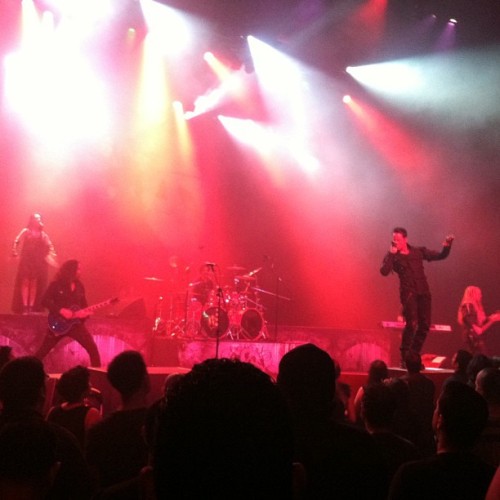I picked up the book Rust Belt Chic on a recent trip to the delightful Mac's Backs in Coventry, and have been enjoying it quite a bit. Not only is it a charming and smart tribute to Cleveland and other Rust Belt locales, but it's helping to elucidate what I suspect is the major reason that I have taken to Cleveland so well: namely that it's a lot like Tampa. Or rather Tampa is a lot like Cleveland, since the Cleve is a much older, larger, and more established city. On the surface they don't look much alike at all--Tampa is tropical, humid and killingly bright, famous for cigars and amusement parks, while Cleveland is possessed of Real Seasons and noted for the intensity of its loathing for LeBron James, the Rock and Roll Hall of Fame, and an abundance of rust. But the two share some specific features that have settled them firmly in my regard.
Industry: Tampa is the seat of heavy industry in Florida. It's home to the largest port in the state and functions as the shipping gateway to Central and South America. Evidence of this is everywhere, from the stretches of industrial ugly on Adamo Drive to the clots of semis flooding Interstates 75, I4, and 275 to the glorious view of shipyards visible from the new highrises in Channelside. Cleveland, of course, is famous or infamous for its heavy industry, chiefly steel manufacturing; seeing the ruin porn of factories and steelyards, the "unplaces" of abandoned warehouses and unfinished building projects make me feel oddly at home here. Fittingly for my Spacecoast USA pride, there's a NASA outpost in Cleveland too, the John Glenn Research Center.
Water: Both cities benefit from their locations on coasts, and the gladness in my heart when my manfriend decided that Cleveland was where his med school lived was initially due to the fact that I wouldn't be landlocked. Growing up on Florida's East Coast and then living for six years on its West Coast, with many sojourns to springs and many days spent on rivers in between, I'm not sure I would have been able to adjust to living in--say--Iowa. Lake Erie and the North Coast, as well as the Cuyahoga River (no longer flammable) and the many area creeks, are a relief to my eyes and to my sensibilities as someone requiring large quantities of water to live. A coastal elite I'll always be.
(downtown Cleveland; photo mine)
Climate/Geography: This is where you say, Diana I think you may have cracked, because yes, it snows in Ohio. In fact, it's snowing right now! (happy spring) However, the summers are just like home, and last summer the temperatures here in the Cleve rose past those in Tampa--I checked. My, it was balmy! My only other frame of reference for summers is New Hampshire, which...sometimes it snows during New Hampshire summers...so to find myself in a place with genuine summer is a blessing. Furthermore, though the geography of northeast Ohio is not at all similar to that of west Florida, the landscape of business is strangely familiar. Once outside the industrial centers of the cities, you'll find farmland and fruit groves in both Hillsborough and Cuyahoga Counties. And I like that a lot about my former and current cities: I like being able to go from the urban beauty of skyscrapers, train tracks, and warehouses to a more rural view of pastures, cows, and bounteous trees.
Microculture: New Yorkers, Los Angelenos, and Seattlites may scoff all they want at midwestern bulwark Cleveland and southeastern ant-hill Tampa, but you'll have a good time in either city. Both contain fucking awesome breweries (Great Lakes, Market Garden, Indigo Imp, and others in the greater Cleveland area, and Cigar City and Florida Avenue in Tampa--perhaps more that I'm not aware of), a reasonable variety of food, museums and gardens, and theme parks if that's what you need. Perhaps they don't have the 24-hour-a-day beat of NYC, the historical patina of Boston, or the Hollywood glamour of LA, but--as Rust Belt Chic points out--a city should not strive to be like other cities; it should strive to be like itself. You can be a foodie in Tampa, a skate punk in Cleveland, a highbrow film nerd in either, and you can roll around in the local history of Eliot Ness (the dude who took down Al Capone) and Santo Trafficante, Jr. (of the Tampa mob family) or take in strange plants at the respective botanical gardens, both located near the cities' major universities.

Now it's possible that all cities are like this, that if I had moved to Des Moines I would feel the same way, or Portland, or Phoenix. But I'm not sure; I remain obsessed with London and Vancouver, but for very different reasons. I think there's some quality that Tampa and Cleveland have, some self-deprecation or carelessness, some stubborn local pride in our casinos and stadiums and suburban sprawl and most of all in what lies beneath that veneer: pierogi and Cubanos, old bricks pushing through concrete in Ybor City and historic settlers buried under a movie theater parking lot in Middleburg Heights.





















